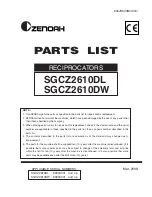
D
19
ENGLISH
DEGB
d) Support large panels to minimise the risk of
blade pinching and kickback.
Large panels tend to
sag under their own weight. Supports must be placed
under the panel on both sides, near the line of cut
and near the edge of the panel.
e) Do not use dull or damaged blades.
Unsharpen-
ed or improperly set blades produce narrow kerf cau-
sing excessive friction, blade binding and kickback.
f) Blade depth and bevel adjusting locking levers
must be tight and secure before making cut.
If
blade adjustment shifts while cutting, it may cause
binding and kickback.
g) Use extra caution when sawing into existing
walls or other blind areas.
The protruding blade
may cut objects that can cause kickback.
Guard function
a) Check guard for proper closing before each
use. Do not operate the saw if guard does not
move freely and enclose the blade instantly.
Never clamp or tie the guard so that the blade is
exposed.
If saw is accidentally dropped, guard may
be bent. Check to make sure that guard moves freely
and does not touch the blade or any other part, in all
angles and depths of cut.
b) Check the operation and condition of the
guard return spring. If the guard and the spring
are not operating properly, they must be serviced
before use.
Guard may operate sluggishly due
to damaged parts, gummy deposits, or a build-up
of debris.
c) Assure that the base plate of the saw will not
shift while performing the “plunge cut” when the
blade bevel setting is not at 90°.
Blade shifting
sideways will cause binding and likely kick back.
d) Always observe that the guard is covering the
blade before placing saw down on bench or floor.
An unprotected, coasting blade will cause the saw
to walk backwards, cutting whatever is in its path. Be
aware of the time it takes for the blade to stop after
switch is released.
Additional Safety and Working
Instructions
Use protective equipment. Always wear safety
glasses when working with the machine. The use of
protective clothing is recommended, such as dust
mask, protective gloves, sturdy non-slip footwear
and ear defenders.
The dust produced when using this tool may be
harmful to health. Do not inhale the dust. Use a dust
absorption system and wear a suitable dust protec-
tion mask. Remove deposited dust thoroughly, e.g.
with a vacuum cleaner.
Always keep the connection cable from the working
area of the device. Always guide the cable backwards,
away from the device!
Do not machine any materials that present a danger
to health (e.g. asbestos).
When working in walls ceiling, or floor, take care to
avoid electric cables and gas or waterpipes.
Please turn the device immediately off when the
tool used gets blocked! Do not turn the device on
again when the tool is still blocked. This could cause
bounce back with a high reaction moment. Determi-
ne and remove the cause of the blocking of the tool
used while respecting the safety instructions.
The possible causes may be:
• it is tilted in the workpiece to be machined
• it has pierced through the material to be machined
• the power tool is overloaded
Do not reach into the machine while it is running.
Chips and splinters must not be removed while the
machine is running.
WARNING! Danger of burns
The insertion tool may become hot during use.
• when changing tools
• when setting the device down
Adapt the feed speed to avoid overheating the blade
tips and to avoid melting plastic materials during
cutting.
Mains Connection
Operation is only allowed with a safety
switch against stray current (RCD max. stray
current of 30mA).
Connect only to single-phase AC system voltage as
indicated on the rating plate. It is also possible to
connect to sockets without an earthing contact as
the design conforms to safety class II. Only plug-in
when machine is switched off.
Maintenance
Unplug the machine before any work on it.
Repairs and works specified in these Instructions may
only be performed by qualified authorised staff.
Use only original accessories and original spare parts.
Keep the device, in particular the air vents, clean at all
times. Never spray water on the device body!
Do not clean the plastics with solvents, flammable or
toxic fluids. For cleaning, use a damp cloth only.
Caution! If the power cord of the appliance gets
damaged, it must be replaced by the manufacturer or
its customer service or a similarly qualified person to
avoid danger.
Only a regularly maintained and treated appliance
can serve as a satisfactory aid. Insufficient mainte-
nance and care can lead to unforeseen accidents and
injuries.
If necessary, a list of spare parts can be found at www.
guede.com.
















































